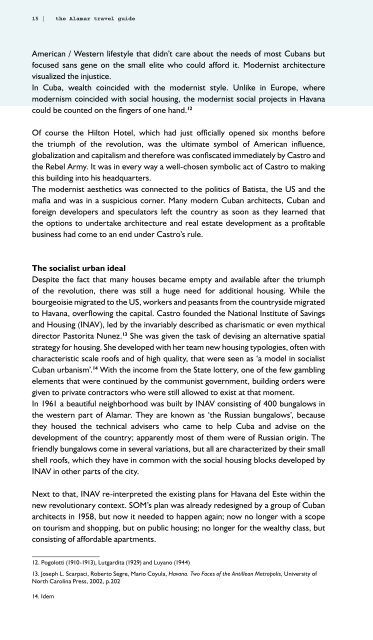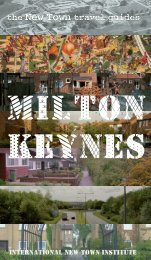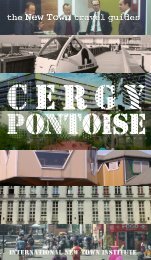You also want an ePaper? Increase the reach of your titles
YUMPU automatically turns print PDFs into web optimized ePapers that Google loves.
15 | the <strong>Alamar</strong> travel guide<br />
American / Western lifestyle that didn’t care about the needs of most Cubans but<br />
focused sans gene on the small elite who could afford it. Modernist architecture<br />
visualized the injustice.<br />
In Cuba, wealth coincided with the modernist style. Unlike in Europe, where<br />
modernism coincided with social housing, the modernist social projects in Havana<br />
could be counted on the fingers of one hand. 12<br />
Of course the Hilton Hotel, which had just officially opened six months before<br />
the triumph of the revolution, was the ultimate symbol of American influence,<br />
globalization and capitalism and therefore was confiscated immediately by Castro and<br />
the Rebel Army. It was in every way a well-chosen symbolic act of Castro to making<br />
this building into his headquarters.<br />
The modernist aesthetics was connected to the politics of Batista, the US and the<br />
mafia and was in a suspicious corner. Many modern Cuban architects, Cuban and<br />
foreign developers and speculators left the country as soon as they learned that<br />
the options to undertake architecture and real estate development as a profitable<br />
business had come to an end under Castro’s rule.<br />
The socialist urban ideal<br />
Despite the fact that many houses became empty and available after the triumph<br />
of the revolution, there was still a huge need for additional housing. While the<br />
bourgeoisie migrated to the US, workers and peasants from the countryside migrated<br />
to Havana, overflowing the capital. Castro founded the National Institute of Savings<br />
and Housing (INAV), led by the invariably described as charismatic or even mythical<br />
director Pastorita Nunez. 13 She was given the task of devising an alternative spatial<br />
strategy for housing. She developed with her team new housing typologies, often with<br />
characteristic scale roofs and of high quality, that were seen as ‘a model in socialist<br />
Cuban urbanism’. 14 With the income from the State lottery, one of the few gambling<br />
elements that were continued by the communist government, building orders were<br />
given to private contractors who were still allowed to exist at that moment.<br />
In 1961 a beautiful neighborhood was built by INAV consisting of 400 bungalows in<br />
the western part of <strong>Alamar</strong>. They are known as ‘the Russian bungalows’, because<br />
they housed the technical advisers who came to help Cuba and advise on the<br />
development of the country; apparently most of them were of Russian origin. The<br />
friendly bungalows come in several variations, but all are characterized by their small<br />
shell roofs, which they have in common with the social housing blocks developed by<br />
INAV in other parts of the city.<br />
Next to that, INAV re-interpreted the existing plans for Havana del Este within the<br />
new revolutionary context. SOM’s plan was already redesigned by a group of Cuban<br />
architects in 1958, but now it needed to happen again; now no longer with a scope<br />
on tourism and shopping, but on public housing; no longer for the wealthy class, but<br />
consisting of affordable apartments.<br />
12. Pogolotti (1910-1913), Lutgardita (1929) and Luyano (1944)<br />
13. Joseph L. Scarpaci, Roberto Segre, Mario Coyula, Havana. Two Faces of the Antillean Metropolis, University of<br />
North Carolina Press, 2002, p.202<br />
14. Idem




